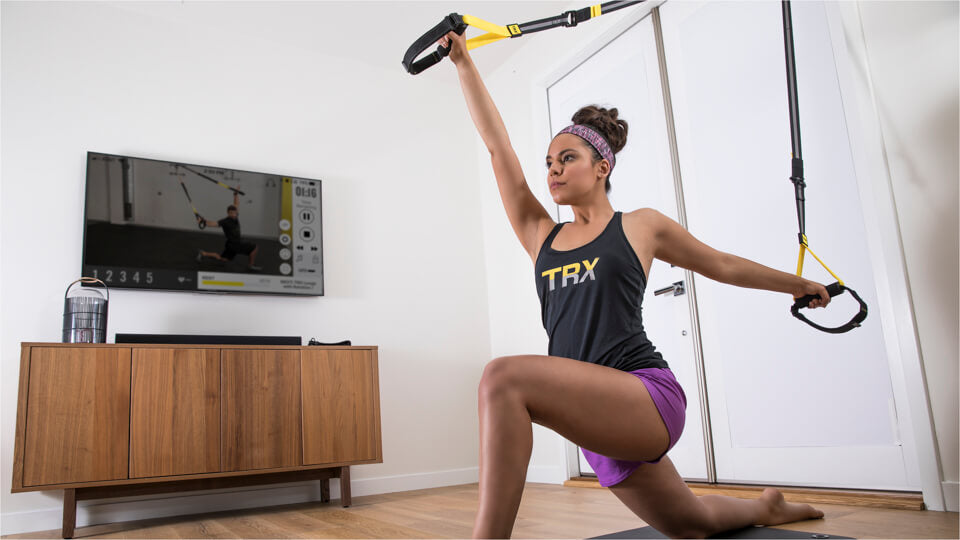If you’ve ever watched MTV Cribs or flipped through the pages of Architectural Digest, you’ve seen a celebrity home gym. They’re usually massive rooms with treadmills, stationary bikes, weight racks, and maybe a massage table or a pitcher of spa water in the corner. For a multi-millionaire athlete or entertainer, that kind of space may be the norm, but most of us don’t have1,000 sq. ft. to commit to our workouts. The good news? You don’t need a mega-mansion to create a top-notch exercise area. Whether you're outfitting a large room or a tiny corner, these are the four things you should think about before creating a workout space

-
What kinds of workouts do you enjoy? Close your eyes and imagine a type of exercise equipment you could keep in a home. Did a treadmill come to mind? Treadmills are great for a quick cardio workout, and they require very little instruction. (You already know how to walk and run, so you don’t have to learn a new type of movement.) If you enjoy running, but you find that weather and timing can interfere with your routine, then an indoor, climate-controlled alternative to your run in the park is appealing. But a treadmill isn’t right for everyone. If you dread running, buying an expensive tool to facilitate running inside isn’t a great idea—you’ll just end up with a large, expensive, unused piece of equipment in your home. Instead of trying to build your workout routine around a piece of equipment, create a home gym that’s focused on the types of exercise you actually do.

-
How much space do you have? Exercise equipment can take up a lot of space. Before you start buying tools for your home gym, take a few minutes to measure how much space you have. Keep in mind, you don’t need a full room. For example, the TRX® Home2™ System offers a full-body workout, but it easily folds for storage in a closet, drawer, and or storage bin. TRX also offers an assortment of small, easily stored functional training tools like bands and slam balls. A Pilates Springboard™ would be anchored to your wall, so you don’t have to worry about giving up floor space or closet space if you want to purchase one for your home. For a larger item, like a weight rack or stationary bike, make sure you have enough floor space to store the equipment before you buy it. You’ll also want to confirm that your staircase or doorway is large enough to accommodate delivery.

-
What is your budget? It’s easy to get carried away when you start shopping for home workout gear. Since you’re making an investment in yourself and your health, you might be tempted to push the boundaries of what your wallet should allow. Don’t get swept up in the moment—especially when you’re dealing with an overly-pushy salesperson at a sporting goods store. Start planning your exercise space by researching prices for the types of equipment you want, then research which brands or models are best for your price range. (For example, if you want to buy a treadmill, Runner’s World writes excellent roundups of home treadmills, complete with their prices.) Remember, you don’t have to buy everything you’ll ever need right now. Don’t be afraid to take a piecemeal approach so you can buy equipment that will meet your needs and last.

- Will an interactive feature help you meet your goals? There’s a reason group fitness is popular: many people want to zone out during a workout and let someone else handle the programming aspect. Historically, that hasn’t been an option with in-home fitness, but the Internet and app-based training programs are making it easy and affordable to work with a fitness professional in your home.
For example, Peloton, the indoor cycling brand, sells a high-end stationary bike with a video screen mounted on the front for live, on-demand classes. (The company offers up to 14 live classes daily, and more than 4,000 on-demand rides.) While Peloton is leading the way in home cycling, it’s a significant investment: the bike itself retails for $1,995, while the streaming subscription service is $39 per month.
TRX also offers a home fitness option. The brand new Home2 System pairs the latest TRX Suspension Trainer™ with curated workouts by world class trainers in the TRX App. The mobile app offers more than 80 workouts across a range of fields like Suspension Training, cycling, running, yoga and high intensity-interval training, a.k.a HIIT. (The app also works with most major wearables to access users’ biometric data, including heart rate, speed and distance.) While the TRX Home2 doesn’t offer live classes, it rings in at a far more affordable price: for less than $200, you get the Suspension Trainer plus a one-year app subscription. After the first year, the TRX App is only $3.99 per year.
Home gyms and personal trainers aren't just for the rich and famous. Whether you're trying to establish a healthy lifestyle, or you simply want to maintain your routine outside of gym hours, there are lots of options for bringing your workout home. With a little time and research, you can create the space that's perfect for your budget and lifestyle.


